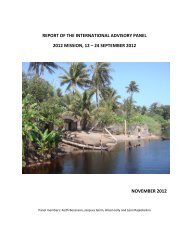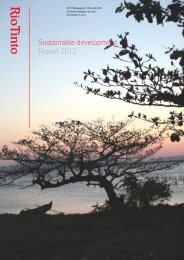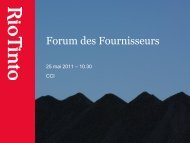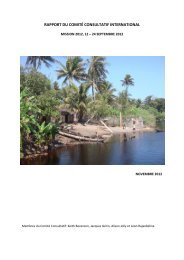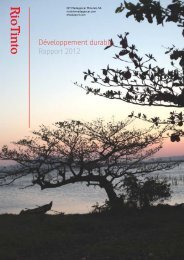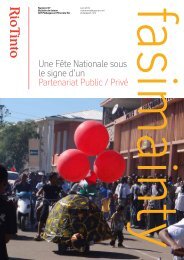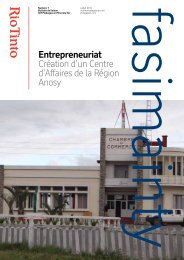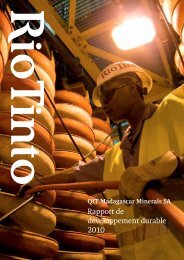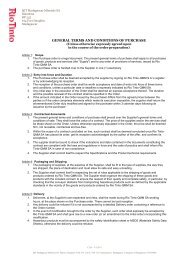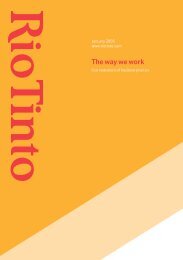Download PDF [ 220 KB ] - Rio Tinto - Qit Madagascar Minerals
Download PDF [ 220 KB ] - Rio Tinto - Qit Madagascar Minerals
Download PDF [ 220 KB ] - Rio Tinto - Qit Madagascar Minerals
Create successful ePaper yourself
Turn your PDF publications into a flip-book with our unique Google optimized e-Paper software.
07_<strong>Madagascar</strong>Revisions_R4 3/7/08 3:38 PM Page 247<br />
Chapter 4.10<br />
Gastrointestinal Parasites of Small Mammals in<br />
the Littoral Forest of Mandena<br />
Brigitte M. Raharivololona 1,2 , Rakotondravao 3 and Jörg U. Ganzhorn 2<br />
Abstract<br />
We screened the fecal samples of 179 individuals of<br />
small mammal species (Primates: Cheirogaleus<br />
major, C. medius, Microcebus murinus, Rodentia:<br />
Eliurus webbi, Rattus rattus, and Afrosoricida:<br />
Setifer setosus) for gastrointestinal parasites.<br />
Nematodes with direct life cycles were most abundant.<br />
They included ascarids (Ascaris sp. and probably<br />
Ascaris petiti), strongylids (Strongyloïdes spp.<br />
and probably Oesophagostomum spp., Ankylostoma<br />
sp., and Chabertia sp.), and trichurids (Trichuris sp.<br />
and Capillaria sp.). We also found trichostrongylids,<br />
tentatively identified as Trichostrongylus sp.,<br />
Nematodirus sp., and Cooperia sp., oxyurids as<br />
Enterobius sp. and probably Heterakis sp.,<br />
Lemuricola sp., and Syphacia sp.; spirurids. Some<br />
helminths with indirect life cycles were also<br />
observed such as the cyclophyllidean cestodes<br />
Hymenolepis spp., and one non-identified form.<br />
Trematode and acanthocephalan were rare and found<br />
only in Microcebus murinus. Coccidia (Protozoa)<br />
occurred frequently. Rats shared many parasites with<br />
the native small mammal species. Since rats also use<br />
non-forested areas, they can spread parasites from<br />
one forest fragment to another. In the large fragments,<br />
the number of different helminthes morphotypes<br />
per individual (HMI), and the number of eggs<br />
found per gram of feces per individual fecal sample<br />
(EPG) of M. murinus and Rattus rattus increased<br />
with the level of degradation. The pair-living<br />
Cheirogaleus medius did not show sex related differences<br />
in any measure of parasite loads (HMI and<br />
EPG). Among the two promiscuous species, male M.<br />
murinus tended to have more different types of parasites<br />
than females, and male R. rattus had higher<br />
EPG than females.<br />
Résumé<br />
Parasites gastro-intestinaux des petits mammifères<br />
de la forêt littorale de Mandena,<br />
<strong>Madagascar</strong>. Nous avons examiné des échantillons<br />
de fèces de 179 individus de petits mammifères<br />
(Primata : Cheirogaleus major, C. medius,<br />
Microcebus murinus ; Rodentia: Eliurus webbi,<br />
Rattus rattus, et Afrosoricida: Setifer setosus) pour<br />
rechercher des parasites gastro-intestinaux. Les<br />
nématodes avec des cycles de vie directs étaient les<br />
plus abondants. Ils incluaient des ascarides avec<br />
Ascaris sp. et vraisemblablement Ascaris petiti ; des<br />
strongylides avec Strongyloïdes spp. (probablement<br />
Oesophagostomum spp., Ankylostoma sp. et<br />
Chabertia sp.) et des trichurides (Trichuris sp. et<br />
Capillaria sp.). Nous avons également trouvé des trichostrongylides<br />
que nous avons provisoirement<br />
attribués à Trichostrongylus sp., Nematodirus sp. et<br />
Cooperia sp. ; des oxyurides tels Enterobius sp.,<br />
probablement Heterakis sp., Lemuricola sp. et<br />
Syphacia sp. ; des spirurides. Quelques helminthes<br />
avec des cycles de vie indirects ont également été<br />
observés comme les cestodes cyclophyllides<br />
Hymenolepis spp. et une forme non identifiée. Les<br />
trématodes et acanthocéphales étaient rares et n’ont<br />
été trouvés que chez Microcebus murinus. Les<br />
Coccidies (Protozoa) existaient avec une très forte<br />
1<br />
Département de Paléontologie et d’Anthropologie<br />
Biologique, BP 906, Université d’Antananarivo,<br />
Antananarivo 101, <strong>Madagascar</strong>. Email:<br />
raharivololonabrigitte@yahoo.fr<br />
2<br />
Department Animal Ecology and Conservation, University<br />
of Hamburg, Martin-Luther-King Platz 3, 20146 Hamburg,<br />
Germany. Email: ganzhorn@zoologie.uni-hamburg.de<br />
3<br />
Département de Recherches Zootechniques et<br />
Vétérinaires/FOFIFA, BP 4, Antananarivo 101,<br />
<strong>Madagascar</strong>.<br />
SI/MAB Series 11 ■ 247
07_<strong>Madagascar</strong>Revisions_R4 3/7/08 3:38 PM Page 248<br />
Figure 1. Location of study areas in the Tolagnaro region. The forest remnants are numbered and shown as dark shading.<br />
Eucalyptus plantations are crosshatched. Swamps with bordering Melaleuca (introduced) are marked with curved<br />
lines (modified from Ramanamanjato and Ganzhorn 2001).<br />
prévalence. Les rats partageaient de nombreux parasites<br />
avec les espèces de petits mammifères<br />
indigènes. Comme les rats utilisent aussi des zones<br />
non forestières, ils peuvent disséminer des parasites<br />
sur des zones ouvertes d’un fragment forestier à un<br />
autre. Dans les grands fragments, le nombre de morphotypes<br />
d’helminthes différents par individu (HMI)<br />
et le nombre d’œufs trouvé par gramme de fèces<br />
(EPG) par échantillon fécal de M. murinus et Rattus<br />
rattus étaient plus élevés dans les fragments<br />
forestiers dégradés que dans les fragments moins<br />
dégradés. Le lémurien vivant en couples,<br />
Cheirogaleus medius, n’a pas montré de différences<br />
entre les sexes dans l’une des mesures de la charge<br />
en parasites (HMI et EPG). Pour les deux espèces<br />
vivant en promiscuité, les mâles M. murinus<br />
tendaient à avoir plus de types de parasites différents<br />
que les femelles et les mâles R. rattus avaient des<br />
EPG supérieurs à ceux des femelles.<br />
Introduction<br />
From a conservation point of view, parasitological<br />
studies are important to understand ways of infection,<br />
and the potential transmission of parasites<br />
between species, both native and introduced<br />
(Goodman 1995, Begon et al. 1999). In addition, the<br />
degree of parasitic infections and the type of parasites<br />
are measures used to assess the health of a population<br />
(e.g., Randriamiadamanana 1998, Junge and<br />
Louis 2002, 2005, Dutton et al. 2003, Randrianjafy<br />
2003), and can be linked to dramatic changes in populations<br />
(e.g., Dobson and Grenfell 1995, Packer et<br />
al. 1999, Daszak et al. 2000).<br />
Within the framework of QIT <strong>Madagascar</strong><br />
<strong>Minerals</strong>’ (QMM) environmental and conservation<br />
activities, it is important to understand whether parasites<br />
can be spread between forest fragments by<br />
introduced rats, which would represent a potential<br />
threat to the survival of endemic species in isolated<br />
conservation zones. It is also of interest to know<br />
whether some of the native or introduced species are<br />
infected by the same parasites as humans (e.g., wild<br />
baboons have died from tuberculosis as a result of<br />
contact with human settlements (Sapolsky and Else<br />
1987), Spirocerca lupi (Nematoda: Spiruridae),<br />
transmitted by dogs, has killed lemurs by aneurysm<br />
in the Parc Zoologique et Botanique de Tsimbazaza,<br />
<strong>Madagascar</strong> (Randriamiadamanana 1998), and apes<br />
and humans share intestinal parasites (Lilly et al.<br />
248 ■ Biodiversity, Ecology and Conservation of Littoral Ecosystems in Southeastern <strong>Madagascar</strong>, Tolagnaro
07_<strong>Madagascar</strong>Revisions_R4 3/7/08 3:38 PM Page 249<br />
2002)). This might represent a mutual threat if parasites<br />
can be exchanged between humans, their<br />
domestic animals, and wild animals. If so, humans<br />
would represent a reservoir of parasites, which could<br />
be spread to the forest, infecting populations of wild<br />
animals. Alternatively, wild animals could be a reservoir<br />
of parasites representing a potential danger to<br />
humans and their domestic animals.<br />
Apart from studies on livestock diseases, which<br />
represent an immediate threat to humans, parasitological<br />
studies on native and introduced mammals<br />
are still in their infancies in <strong>Madagascar</strong>, and there is<br />
no comprehensive, standard literature that can be<br />
used for parasite identification without sophisticated<br />
molecular methods (e.g., Chabaud et al. 1964, 1965,<br />
Euzeby 1981). Gastrointestinal parasites represent<br />
one functional group of parasites, which can be used<br />
for monitoring the health of a population, and to<br />
address the questions mentioned above. However,<br />
with respect to parasites of the digestive tract, it is<br />
difficult to assign recovered eggs to a specific taxon.<br />
In this study, we investigated gastrointestinal parasites<br />
of small mammals in the Mandena Forest. The<br />
goal was to provide a baseline for future monitoring.<br />
More specifically, we addressed which gastrointestinal<br />
parasites are present in small, non-volant mammals<br />
of the Mandena Forest? Which of these parasites<br />
occur in more than one species, making interspecific<br />
transmission possible? Is there any relationship<br />
between forest degradation and the size of fragments,<br />
and parasite infections?<br />
Methods<br />
Study site<br />
The study was carried out in fragments M5, M13,<br />
M15/M16, and M20 of the littoral forest of<br />
Mandena, some 12 km northeast of Tolagnaro, at<br />
sites ranging in altitude from 0 to 20 m. The forest<br />
fragments differed in size and degree of degradation<br />
(see Vincelette et al. Chapter 2.4). Fragments were<br />
classified as: small and degraded (M20); large and<br />
degraded (M13); small and less degraded than M20<br />
(M5); and large and less degraded than M13<br />
(M15/M16).<br />
Small mammals were captured with Tomahawk<br />
and Sherman live traps using standard procedures<br />
(Ramanamanjato and Ganzhorn 2001) at permanent<br />
study sites set up in different forest fragments of<br />
Mandena. Traps baited with banana were set 4 nights<br />
per month at 80 - 100 localities per fragment between<br />
April and October 2003. Additional samples were<br />
provided by Petra Lahann, Nina Rüdel, Jörg Schüller,<br />
and Björn Siemers. The samples collected by Petra<br />
Lahann had been collected in M15/M16 between<br />
November 2003 and March 2004. Trapped animals<br />
were sexed, measured, weighed, and marked permanently<br />
with sub-dermal transponders. Animals were<br />
released at the locality where they were captured.<br />
Study species<br />
Cheirogaleus major, the Greater Dwarf Lemur,<br />
ranges in weight from 350 to 600 g. This species is<br />
arboreal, nocturnal, and omnivorous, feeding on<br />
fruit, flowers, young leaves, and insects. They forage<br />
alone, but sleep in small groups during the day. This<br />
species is found across a broad altitudinal range in<br />
the Malagasy eastern rain forests (Mittermeier et al.<br />
2006, Lahann 2007b).<br />
Cheirogaleus medius, the Fat-tailed Dwarf<br />
Lemur, is also arboreal and nocturnal. This species<br />
hibernates during the dry or cool season. Its weight<br />
varies seasonally, ranging from an average of 142 g<br />
at the beginning of the rainy season, to 217 g at the<br />
end (before hibernation). They have a diverse diet<br />
comprised mainly of fruit and flowers (nectar), but<br />
also feed on insects and small vertebrates (Hladik et<br />
al. 1980, Fietz and Ganzhorn 1999, Dausmann et al.<br />
2005). This lemur is a solitary forager, but sleeps in<br />
groups in tree holes during the day. It occurs in the<br />
dry deciduous forests of the west, but extends into<br />
the evergreen littoral forests around Tolagnaro<br />
(Mittermeier et al. 2006).<br />
Microcebus murinus, the Gray Mouse Lemur, is<br />
a small (average 60 g), nocturnal, and omnivorous<br />
lemur. It has a wide dietary spectrum that consists<br />
primarily of insects, fruit, flowers, and leaves. They<br />
also eat sap, gum, secretions from homopteran larvae,<br />
and small vertebrates such as frogs, geckos, and<br />
chameleons. This lemur forages alone, but congregates<br />
at daytime sleeping sites. It is arboreal, polygynous,<br />
and distributed throughout western, southern,<br />
and southeastern <strong>Madagascar</strong>. They occur in primary,<br />
secondary, and disturbed forest habitats (Martin 1972,<br />
Petter et al. 1977, Lahann et al. 2006).<br />
Rattus rattus, the Black Rat, has an average adult<br />
weight of about 100 g in the study area<br />
(Ramanamanjato and Ganzhorn 2001). They are<br />
omnivorous, live in groups without a hierarchical<br />
structure, and are mate binding (Mohr 1950). Rattus<br />
SI/MAB Series 11 ■ 249
07_<strong>Madagascar</strong>Revisions_R4 3/7/08 3:38 PM Page 250<br />
rattus may have been introduced to <strong>Madagascar</strong> as a<br />
human commensal as early as the 11 th century. Since<br />
then, it has spread into the most remote parts of the<br />
native forests. R. rattus and its ecto-parasites carry a<br />
variety of diseases such as bubonic plague, which can<br />
be transmitted to both native species and humans<br />
(Goodman 1995, Goodman et al. 1997, Duplantier and<br />
Duchemin 2003, Duplantier et al. 2003, Laakkonen et<br />
al. 2003, Rousset and Andrianarivelo 2003).<br />
Eliurus webbi ranges in weight from 55 to 95 g.<br />
It seems that this endemic rodent nests and forages<br />
in the low branches of trees, and at ground level, on<br />
lianas, and the lower branches of trees. It feeds on<br />
seeds, fruits, and possibly on invertebrates. This<br />
species probably lives in pairs in ground burrows up<br />
to 1 m in depth. It is found in undisturbed lowland<br />
and mid-altitude rainforests from Montagne<br />
d’Ambre in the north to the region of Tolagnaro in<br />
the southeast (Goodman et al. 2003).<br />
Setifer setosus is a nocturnal animal with an average<br />
adult weight of about 225 g. It is omnivorous,<br />
eating a wide range of fruits, insects, grubs, and<br />
other invertebrates, as well as scavenging. It mainly<br />
forages at ground level, but is known to climb.<br />
Depending on the seasonal environmental conditions,<br />
this species can be active throughout the year<br />
or become torpid for short periods. The male and<br />
female are temporarily together during the breeding<br />
season, but adults seem to usually live solitarily.<br />
Setifer setosus occurs throughout the island, even in<br />
some urban areas, and occasionally near rubbish<br />
(Goodman et al. 2003).<br />
Fecal sampling and parasite identification<br />
Gastrointestinal parasites were identified from feces.<br />
For this, fresh feces were collected from handling<br />
bags or traps and stored in vials containing 4%<br />
formaldehyde. A modification of the McMaster flotation<br />
egg counting technique (Sloss et al. 1994) was<br />
applied to analyze egg shedding, which has been considered<br />
a valid method of evaluating worm burdens in<br />
several studies (e.g., Gulland et al. 1993, Paterson et<br />
al. 1998, Coltman et al. 1999, Cassinello et al. 2001).<br />
For this and for quantitative analyses, 300 mg of feces<br />
were triturated in a beaker with 3 ml of a saturated<br />
potassium iodide solution (KI) with a specific weight<br />
of 1.5 g/ml (Meyer-Lucht and Sommer 2005). The<br />
high specific density improves the detectability of<br />
eggs with high specific density, such as those of some<br />
nematodes and trematodes (Thienpont et al. 1996, in<br />
Harf and Sommer 2005). The mixture was poured<br />
through a tea strainer to eliminate large, non-digested<br />
particles. The residue in the tea strainer was washed<br />
with 1 ml of KI. The suspension was filled to a volume<br />
of 4.5 ml with the KI solution, stirred again, and<br />
transferred to both chambers of a McMaster counting<br />
chamber with a pipette. The slide was transferred to a<br />
microscope and left still for 5 minutes before examination.<br />
During this time, eggs and larvae floated to the<br />
surface of the McMaster counting chambers. The<br />
slide was then examined with 100x, 400x, and 600x<br />
magnification to identify and count all eggs and larva<br />
inside the ruled squares. This procedure has been<br />
applied successfully in a number of other studies (e.g.,<br />
Meyer-Lucht and Sommer 2005, Schad et al. 2005).<br />
Parasites were measured with a calibrated ocular<br />
micrometer, and photographed with a digital camera.<br />
Parasite identification was based on the size, shape,<br />
and internal structure of eggs, oocyst, and larvae<br />
(Chabaud et al. 1964, 1965, Euzeby 1981). The identifications<br />
and data presented here for the three lemur<br />
species have also been summarized, and their parasites<br />
have been illustrated by Raharivololona (2006). The<br />
taxonomic identifications still have to be considered<br />
preliminary. Pictures of the parasites and the names<br />
assigned to the different forms are displayed at<br />
http://www.biologie.uni-hamburg.de/zim/oeko.<br />
Statistical analyses<br />
For the statistical analyses, each captured mammal was<br />
used only once. For recaptures, we normally used the<br />
fecal sample taken at the first capture. Some individuals<br />
were recaptured throughout the year. Only parasites<br />
from adults were used in the quantitative analyses.<br />
Juveniles were excluded because they are likely to<br />
have different parasite loads than adults. The total<br />
number of eggs per gram of fecal material was log10<br />
transformed to facilitate illustrations. The number of<br />
parasite species was not transformed. Significance levels<br />
are two-tailed, and based on non-parametric tests.<br />
Statistical tests were run with SPSS 9.0 (SPSS 1999).<br />
Results<br />
Parasite diversity<br />
In total, 350 fecal samples were collected from 179<br />
individuals, including 2 Cheirogaleus major, 26 C.<br />
medius, 105 Microcebus murinus, 36 Rattus rattus, 8<br />
Eliurus webbi, and 3 Setifer setosus. The prevalence<br />
250 ■ Biodiversity, Ecology and Conservation of Littoral Ecosystems in Southeastern <strong>Madagascar</strong>, Tolagnaro
07_<strong>Madagascar</strong>Revisions_R4 3/7/08 3:38 PM Page 251<br />
rates of different parasites are listed in Table 1.<br />
Individuals with parasites varied from 73% to 100%<br />
in the six species.<br />
Cheirogaleus major<br />
The feces of both individuals contained coccidia<br />
(Protozoa), and one non-identified species of nematode.<br />
The coccidian is likely to be Eimeria.<br />
Cheirogaleus medius<br />
Parasites belonged to: Nematodea — Strongyloïdes,<br />
strongylids, Trichuris, oxyurids, and 3 unidentified<br />
morphotypes. Based on morphological structures,<br />
strongylids could be Oesophagostomum,<br />
Ankylostoma, and Chabertia; one form of strongylid<br />
could not be identified. Oxyurids found in the feces<br />
resemble Heterakis; Cestodea - Hymenolepis and other<br />
cyclophyllidean species; Protozoa — Coccidia<br />
(Eimeria ?). Intestinal parasites with the highest prevalence<br />
rates were Trichuris (26.9%), Hymenolepis<br />
(26.9%), and coccidia (26.9%, Table 1).<br />
Microcebus murinus<br />
Parasites belonged to: Nematodea — Ascaris sp.<br />
found in only one individual; one non identified<br />
species of ascarid; Strongyloïdes, strongylids (several<br />
forms, including probably Oesophagostomum and<br />
Ankylostoma), Trichuris, Capillaria;<br />
Trichostrongylids (several forms, including probably<br />
Trichostrongylus and Nematodirus); Oxyurids —<br />
Enterobius, two other species seem to be Lemuricola<br />
and Syphacia. Three forms could not identified further;<br />
Cestodea — Hymenolepis and other morphotypes<br />
of cyclophyllidean; Trematodea and<br />
Acanthocephala — found in two individuals;<br />
Protozoa — Coccidia (Eimeria) is the most common<br />
intestinal parasite with a prevalence rate of<br />
68.3%. Capillaria, Enterobius, trichostrongylids,<br />
trematodes, and acanthocephala were very rare.<br />
Apart from Coccidia infections, many animals were<br />
also infected by Hymenolepis (33.7%; Table 1).<br />
Eliurus webbi<br />
Only five species of nematodes were found in the feces<br />
of this species. They were mainly strongylids, which<br />
seem to be Oesophagostomum and Ankylostoma (prevalence<br />
= 75%), Strongyloïdes, possibly Trichostrongylus,<br />
and one unknown form of nematodes.<br />
Rattus rattus<br />
Parasites belonged to: Nematodea — Ascaris, one<br />
non identified species of ascarids, strongylids (morphologically<br />
similar to Oesophagostomum or<br />
Ankylostoma, Strongyloïdes), trichurids (Trichuris,<br />
Capillaria), trichostrongylids (probably Trichostrongylus,<br />
Cooperia), oxyurids (possibly Syphacia),<br />
one species of spirurids and four nematodes could<br />
not be identified further. According to this preliminary<br />
result, R. rattus is the only species infected by<br />
spirurids; Cestodea — only Hymenolepis spp.;<br />
Protozoa: — Coccidia (Eimeria?). Rats were highly<br />
infected by Strongyloïdes and strongylids (63.9%<br />
and 61.1%, respectively; Table 1).<br />
Setifer setosus<br />
Parasites belonged to: Nematodea — strongylids<br />
(probably Oesophagostomum and Ankylostoma),<br />
Strongyloïdes, Trichuris, Capillaria, and three<br />
unknown forms; Cestodea — Hymenolepis;<br />
Acanthocephala; Protozoa — Coccidia (Eimeria ?).<br />
Parasite load in relation to forest<br />
degradation and fragment size<br />
The number of eggs found per gram of feces per<br />
individual (FEC: fecal egg count), and the number of<br />
different helminthes morphotypes per individual<br />
(HMI) were used as indicators for the intensity of<br />
parasitism (Table 2). Quantitative analyses were not<br />
available for all fecal samples, therefore, sample<br />
sizes given in Table 2 are slightly lower than those in<br />
Table 1. Only Microcebus murinus and Rattus rattus<br />
were caught in sufficient numbers at all the various<br />
study sites to allow statistical analyses of possible<br />
effects of fragment size and forest degradation on<br />
parasite loads.<br />
Microcebus murinus: Effect of degradation<br />
Since the data deviated significantly from a normal<br />
distribution, only non-parametric tests could be<br />
used. Therefore, we analyzed large and small fragments<br />
separately. For large fragments (M13 (degraded)<br />
– M15/M16 (less degraded)), the number of parasite<br />
species found in the feces differed significantly<br />
between the animals caught in M13 and those caught<br />
in M15/M16 (Mann Whitney U test: z = 1.94, p =<br />
0.05). The difference, with respect to the fecal egg<br />
count, was not significant even though more eggs<br />
SI/MAB Series 11 ■ 251
07_<strong>Madagascar</strong>Revisions_R4 3/7/08 3:38 PM Page 252<br />
Table 1. Habitat specificity of host species and prevalence of gastrointestinal parasites found in feces of Cheirogaleus<br />
major, C. medius, Microcebus murinus, Eliurus webbi, Rattus rattus, and Setifer setosus in the littoral forest of<br />
Mandena. Prevalence = Number of infected individuals divided by the number of examined individuals (%). Total number<br />
of parasite morphotypes = Number of morphotypes recorded for the different host species. Parasite morphotypes per<br />
sample = Number of different parasite morphotypes found per fecal sample. Values are medians and ranges; for sample<br />
sizes less than three all values are listed.<br />
Restricted to forest habitats<br />
Forest and non-forest habitats<br />
Primates Rodentia Afrosoricida<br />
C. major C. medius M. murinus E. webbi R. rattus S. setosus<br />
N = 2 N =26 N = 105 N = 8 N = 36 N = 3<br />
Nematodea<br />
Ascaris sp. 1.0 13.9<br />
other ascarids 25.7 8.3<br />
Strongyloïdes spp. 3.9 11.9 12.5 63.9 33.3<br />
strongylids 11.5 4.0 75.0 61.1 33.3<br />
Trichuris sp. 26.9 8.9 11.1 33.3<br />
Capillaria sp. 1.0 8.3 33.3<br />
trichostrongylids 2.0 12.5 13.9<br />
Enterobius sp. 1.0<br />
other oxyurids 3.9 15.8 5.6<br />
spirurids 8.3<br />
Non identified<br />
nematodes 50.0 26.9 59.4 25.0 11.1 66.6<br />
Cestodea<br />
Hymenolepis spp. 26.9 33.7 5.6 33.3<br />
other Cyclophyllidean 3.9 5.0<br />
Trematodea 2.0<br />
Acanthocephala 2.0<br />
Protozoa: Coccidia 100.0 26.9 68.3 8.3 100.0<br />
Total prevalence 100.0 73.1 90.1 87.5 86.1 100.0<br />
Parasite 1 / 2 1 2 2 2 3 / 3 / 7<br />
morphotypes / sample 0 – 4 0 – 7 0 – 3 0 – 7<br />
Total number of<br />
parasite morphotypes 3 13 ≥ 20 5 ≥ 17 ≥ 10<br />
were found in the feces of animals in the more<br />
degraded fragment (z = 1.86, p = 0.06). For the small<br />
fragments (M20 (degraded) - M5 (less degraded)),<br />
the number of parasite morphotypes did not differ (z<br />
= 0.74, n.s.), but the number of eggs found in the<br />
feces was significantly higher in M5 than in M20 (z<br />
= 2.03, p = 0.04).<br />
Microcebus murinus: Effect of fragment size<br />
In degraded fragments (M13 (large) – M5 (small)),<br />
and less degraded fragments (M15/M16 (large) –<br />
M20 (small)), neither the number of parasite species,<br />
nor the number of eggs found in the feces differed<br />
between fragments of different size (z < 1.67 for all<br />
comparisons, n.s.).<br />
Rattus rattus: Effect of degradation<br />
Since no rats were captured in M20, analysis of the<br />
effect of degradation had to be restricted to the comparison<br />
between the large fragments (M13 (degraded) –<br />
M15/M16 (less degraded)). Animals caught in the<br />
degraded fragment M13 had significantly more parasite<br />
varieties, and many more parasite eggs in their feces (z<br />
= 2.66, p = 0.008; z = 2.53, p = 0.01, respectively).<br />
Rattus rattus: Effect of fragment size<br />
Due to the lack of captures in M20, analysis of the<br />
effect of the size of fragments had to be restricted to<br />
the comparison between the degraded fragments<br />
(M13 (large) – M5 (small)). In this case, animals<br />
caught in the large fragment had more different par-<br />
252 ■ Biodiversity, Ecology and Conservation of Littoral Ecosystems in Southeastern <strong>Madagascar</strong>, Tolagnaro
07_<strong>Madagascar</strong>Revisions_R4 3/7/08 3:38 PM Page 253<br />
asite forms, and excreted more parasite eggs than the<br />
animals in the small fragment (z = 2.10, p = 0.04; z<br />
= 2.39, p = 0.015, respectively).<br />
Sex differences in parasite loads<br />
Cheirogaleus medius did not show differences in any<br />
measure of parasite loads (HMI and EPG) between<br />
the sexes (Figs. 2, 3). Male Microcebus murinus<br />
tended to have more different types of parasites than<br />
females (HMI: males - median = 2, quartiles = 1-3,<br />
n = 45; females - median = 1, quartiles = 0-2, n = 52,<br />
Mann Whitney U test: z = 1.88, p = 0.06). EPG did<br />
not differ significantly between the sexes of this<br />
species. Male Rattus rattus also had a non-significant<br />
tendency for greater HMI than females (HMI:<br />
males - median = 2, quartiles = 2-3, n = 20; females<br />
- median = 2, quartiles = 0-3, n = 15, Mann Whitney<br />
U test: z = 1.64, p = 0.10). Male rats did, however,<br />
have significantly higher EPG than females (EPG:<br />
males - median = 2.68, quartiles = 2.48–2.99, n = 20;<br />
females - median = 2.18, quartiles = 0–2.70, n = 15,<br />
Mann Whitney U test: z = 2.29, p = 0.02).<br />
Discussion<br />
Only preliminary taxonomic identifications are presented<br />
here. During a visit to the Muséum national<br />
d’Histoire naturelle, Paris, France, no parasite egg<br />
samples, only larva and adult worms, could be located<br />
in their important reference collection. Therefore,<br />
an open access database was created to advance<br />
towards more comprehensive means of identification<br />
of Malagasy small mammal parasites<br />
(Raharivololona 2006). In addition, future work will<br />
include larval cultures and experimental transmission<br />
of parasites to laboratory rats in order to obtain<br />
larva and adult worms for comparison. This is a<br />
long-term project and the taxonomic interpretations<br />
presented here are likely to need revision sometime<br />
in the future.<br />
In the present survey, all small mammal species<br />
had high prevalence infection rates (> 73%) and<br />
were hosts for 3 to 20+ gastrointestinal parasite<br />
forms. For lemurs Chabaud et al. (1965) listed some<br />
intestinal nematode parasites as: strongylids:<br />
Lemurostrongylus residuus; trichostrongylids:<br />
Table 2. Number of different helminthes morphotypes per individual (HMI), and number of eggs found per gram of<br />
feces per individual (EPG). Values are medians and quartiles. N = sample size. For a sample size of 2, both values<br />
are listed.<br />
M5 M13 M15/M16 M20<br />
Size 28 ha 150 ha 230 ha 20 ha<br />
Degradation low high low high<br />
HMI EPG HMI EPG HMI EPG HMI EPG<br />
Cheirogaleus major 1 / 2 1.71 / 3.51<br />
N = 2<br />
Cheirogaleus medius 1 2.30 1 1.71 1 2.00<br />
0-2 0-2.54<br />
N = 1 N = 1 N = 23<br />
Microcebus murinus 2 3.79 2 3.02 1 2.18 2 2.95<br />
1.5-5 3.01-4.18 1-3 2.18-3.46 0-2 0 – 3.26 1-3 2.30-3.57<br />
N = 9 N = 14 N = 63 N = 15<br />
Eliurus webbi 2 2.48 2 2.40<br />
1-3 2.18-2.89<br />
N = 6 N = 1<br />
Rattus rattus 2 2.51 3 2.93 2 2.30<br />
1.75-3 1.93-2.78 2-5 2.54-3.92 1-3 1.71-2.70<br />
N = 14 N = 11 N = 11<br />
Setifer setosus 3 / 7 3.41/5.18 3 4.16<br />
N = 2 N = 1<br />
SI/MAB Series 11 ■ 253
07_<strong>Madagascar</strong>Revisions_R4 3/7/08 3:38 PM Page 254<br />
Number of Helminthes<br />
Figure 2. Number of helminthes morphotypes in female<br />
(F) and male (M) Cheirogaleus medius, Microcebus murinus,<br />
and Rattus rattus. Values are medians, 10, 25, 75<br />
and 90% percentiles and values outside the 10 / 90%<br />
percentiles.<br />
Number of Helminthes<br />
Figure 3. Number of helminthes eggs per gram of fecal<br />
sample in female (F) and male (M) Cheirogaleus medius,<br />
Microcebus murinus, and Rattus rattus; for details see<br />
Fig. 2.<br />
Pararhabdonema longistriata; oxyurids: Callistoura<br />
spp., Lemuricola spp., Biguetius trichuroides and<br />
Enterobius lemuris; subulurids: Subulura baeri;<br />
ascarids: Ascaris petiti; spirurids: Spirura diplociphos<br />
and Rictularia lemuris; and trichurids:<br />
Trichuris lemuris. In the present study, strongylids<br />
were identified as Oesophagostomum sp.,<br />
Ankylostoma sp., and Chabertia sp.<br />
Oesophagostomum sp. is also known to infect lemurs<br />
in captivity in the Tsimbazaza Zoo, Antananarivo<br />
(Randriamiadamanana 1998). Trichostrongylids in<br />
our data set are likely to be Trichostrongylus sp.<br />
Oxyurids that we have identified are probably<br />
Enterobius sp., Heterakis sp., Lemuricola sp., and<br />
Syphacia sp. One non-identified nematode of<br />
Cheirogaleus medius and Microcebus murinus could<br />
be a subulurid, probably Subulura sp.<br />
The Ascaris sp. observed in the present samples<br />
of Microcebus murinus and Rattus rattus could be A.<br />
lumbricoïdes. Its occurrence in M. murinus can be<br />
explained by the fact that M. murinus descends to the<br />
ground to catch invertebrates, and thus, is exposed to<br />
human intestinal parasites since people frequently<br />
enter the Mandena Forest. It would be most important<br />
to follow-up on possible pathways of gut infections<br />
between humans, rats, and lemurs. One nonidentified<br />
nematode of Cheirogaleus medius and M.<br />
murinus is likely to be a spirurid, such as<br />
Physaloptera sp. The trichurid (Trichuris lemuris)<br />
described by Chabaud et al. (1965) seems to be the<br />
same species as that found in the present study.<br />
Capillaria sp. has also been found in fecal samples<br />
of M. murinus.<br />
The study presented here expounds upon considerably<br />
the information provided by Chabaud et al.<br />
(1965). Those authors identified four species of<br />
intestinal parasites present in M. murinus, while in<br />
the current work, at least 20 different forms were<br />
collected. Chabaud et al. (1965) examined two parasite<br />
species in Cheirogaleus major, Lemuricola contagiosus<br />
and Trichuris lemuris. We did not find these<br />
taxa, but rather coccidian, and one species of nematode.<br />
Further, Chabaud et al. (1965) reported only<br />
Subulura baeri and Spirura diplocyphos as the intestinal<br />
parasites of C. medius, as compared to at least<br />
13 different forms found in this lemur from the<br />
Mandena sample. Finally, the fecal samples from<br />
Mandena contained cestodes (Hymenolepis and<br />
cyclophyllidean) for C. medius and M. murinus, a<br />
trematode and acanthocephalan for M. murinus, and<br />
coccidia in all three lemur species studied.<br />
Apart from food composition and resource utilization<br />
(e.g., Dobson and Pacala 1992, Guegan and<br />
Kennedy 1993), the degree of parasitism can be<br />
influenced by social interactions. Parasites such as<br />
ascarids, strongylids, trichurids, and trichostrongylids<br />
are transmitted directly through<br />
feces. Inter-individual exchange of parasites is possible,<br />
for example, among animals of the same sleeping<br />
group. These social interactions generate a network<br />
of contacts within populations through which<br />
many parasites can spread (Anderson and May 1979,<br />
1991). Hosts living at high density or with frequent<br />
intra-specific contacts are expected to accumulate<br />
254 ■ Biodiversity, Ecology and Conservation of Littoral Ecosystems in Southeastern <strong>Madagascar</strong>, Tolagnaro
07_<strong>Madagascar</strong>Revisions_R4 3/7/08 3:38 PM Page 255<br />
more parasite species (Morand 2000, Roberts et al.<br />
2002). This might explain why parasite prevalence is<br />
higher in M. murinus than in the other two lemur<br />
species. In C. medius, which lives in pairs, males and<br />
females share the same home range (Lahann 2006,<br />
2007a), and the two sexes do not differ in the intensity<br />
of their infections. In contrast, males of the<br />
promiscuous species M. murinus and R. rattus have<br />
more different parasites and higher parasite infections<br />
than females. This might be because males<br />
range over larger areas than females (M. murinus in<br />
M15/M16: males - about 3 ha, females - 0.5 ha;<br />
Lahann et al. 2006).<br />
Oxyurids, cestodes, trematodes, and acanthocephalan<br />
have an indirect life cycle with arthropods<br />
as intermediate hosts (Flynn 1973; Owen 1992).<br />
Since all three lemur species considered here eat<br />
invertebrates (Mittermeier et al. 2006), they can all<br />
be infected by these parasites simply through their<br />
standard dietary regime.<br />
Parasites of Malagasy nesomyine rodents are less<br />
studied than parasites of other groups. One species<br />
of trichostrongylids (Heligmonina tanala) has been<br />
recently identified in Eliurus tanala from Parc<br />
National de Ranomafana (Durette-Desset et al.<br />
2002). Rattus rattus is infected by almost all groups<br />
of parasites found in the endemic host species except<br />
for trematodes and Acanthocephala. Since rats move<br />
freely between forest fragments and human habitations,<br />
they are the most likely candidates for parasite<br />
transmission.<br />
Chabaud et al. (1964) described at least five<br />
forms of gastrointestinal parasites in Setifer setosus,<br />
Uncinaria bauchoti (strongylids), Bioccastrongylus<br />
bioccai (strongylids), Molineus odgeni (trichostrongylids),<br />
Physaloptera coelebs coelebs<br />
(spirurids), Physaloptera coelebs bluntschlii<br />
(spirurids), and ascarids. In the present study, we<br />
identified strongylids, which seem to be<br />
Oesophagostomum sp. and Ankylostoma sp.,<br />
Strongyloïdes sp., Trichuris sp., Capillaria sp., three<br />
unknown species of nematodes, Hymenolepis sp.,<br />
Acanthocephala, and Coccidia. Being insectivorous,<br />
it is not surprising to find cestodes and<br />
Acanthocephala in the feces of Setifer setosus, as<br />
these parasites have indirect life cycles with arthropods<br />
as intermediate hosts.<br />
The intensity of parasitism varied between<br />
species and between forest fragments. Parasitism<br />
was elevated in more degraded forests. For the time<br />
being, it is not known how environmental conditions<br />
affect parasite loads. Recently, parasite resistance<br />
and susceptibility was linked to specific properties<br />
of genes involved in the immune responses of individual<br />
M. murinus and C. medius (Schad et al. 2005,<br />
see Sommer Chapter 4.11, N. Schwensow, unpubl.<br />
data). In the case of M. murinus, the allele that was<br />
linked to susceptibility was more frequent in the<br />
degraded forest fragment (M5) than in fragments<br />
M13, M15/M16, and M20. In the context of this<br />
work, C. medius was studied in a different region of<br />
<strong>Madagascar</strong>. Thus, it is not known whether high parasite<br />
loads on the population level are due to the<br />
environmental situation, population densities, or the<br />
genetic constitution of the animals.<br />
In summary, a diverse gastrointestinal parasite<br />
fauna was found in the small mammals of the<br />
Mandena Forest. Parasite load increased with the<br />
increasing degradation of the forest. The possible<br />
parasite transmission from humans to wildlife and<br />
vice versa deserves special attention (i.e. the occurrence<br />
of Ascaris sp. in M. murinus, R. rattus, and<br />
humans).<br />
Acknowledgments<br />
The study was conducted under the Accord de<br />
Collaboration between the Université<br />
d’Antananarivo (Département de Biologie Animale<br />
and Département d’Anthropologie et de Biologie<br />
Evolutive) and Hamburg University. It is part of the<br />
biodiversity assessment and environmental impact<br />
studies of the littoral forest fragments initiated by<br />
QIT <strong>Madagascar</strong> <strong>Minerals</strong> (QMM). We thank Refaly<br />
Ernest for assistance with the fieldwork; Manon<br />
Vincelette, Jean-Baptiste Ramanamanjato, and their<br />
environmental and conservation team, as well as<br />
other staff of QMM, for technical assistance and<br />
help with logistics; Simone Sommer, her students,<br />
and staff at the Department of Animal Ecology and<br />
Conservation, Hamburg University; Dr. Frédéric<br />
Ariey and the Malaria Department of the Institut<br />
Pasteur de <strong>Madagascar</strong>; Gervais Randrianarivo and<br />
the Département de Recherches Zootechniques et<br />
Vétérinaires / FOFIFA for help and assistance in the<br />
laboratory analyses. We also thank Prof. D.W.<br />
Büttner (Bernhard Nocht Institute, Hamburg), Prof.<br />
Alain G. Chabaud, Dr. Odile Bain, and Dr. Marie-<br />
Claude Durette-Desset (Muséum national d’Histoire<br />
naturelle, Paris), and Dr. David Modry (Department<br />
SI/MAB Series 11 ■ 255
07_<strong>Madagascar</strong>Revisions_R4 3/7/08 3:38 PM Page 256<br />
of Parasitology, University of Veterinary and<br />
Pharmaceutical Sciences, Czech Republic) for their<br />
advice. Nina Schwensow provided very helpful comments<br />
on previous drafts of the manuscript. This<br />
study was funded by the Margot Marsh Biodiversity<br />
Foundation, QMM, German Research Foundation<br />
(DFG), and the German Academic Exchange<br />
Service (DAAD).<br />
References<br />
Anderson, R.M. and R.M. May. 1979. Population biology<br />
of infectious diseases. I. Nature 280:361-367.<br />
Anderson, R.M. and R.M. May. 1991. Infectious<br />
Diseases of Humans: Dynamics and Control.<br />
Oxford University Press, Oxford.<br />
Begon, M., S.M. Hazel, D. Baxby, K. Brown,<br />
Cavanagh, R. Chantrey, J. Jones, T. and M. Bennett.<br />
1999. Transmission dynamics of a zoonotic<br />
pathogen within and between wildlife host species.<br />
Proceedings of the Royal Society of London B,<br />
Biological Sciences 266:1-7.<br />
Cassinello, J., M. Gomendio and E.R.S. Roldan. 2001.<br />
Relationship between coefficient of inbreeding and<br />
parasite burden in endangered gazelles.<br />
Conservation Biology 15:1171-1174.<br />
Chabaud, A.G., E.R. Brygoo and R. Tchéprakoff. 1964.<br />
Nématodes parasites d’insectivores malgaches.<br />
Bulletin du Muséum national d’Histoire naturelle,<br />
Paris 36:245-261.<br />
Chabaud, A.G., E.R. Brygoo and A.-J. Petter. 1965. Les<br />
nématodes parasites de lémuriens malgaches.<br />
Description de six espèces nouvelles et conclusions<br />
générales. Annales de Parasitologie (Paris) 40:181-<br />
214.<br />
Coltman, D.W., J.G. Pilkington, J.A. Smith and J.M.<br />
Pemberton. 1999. Parasite-mediated selection<br />
against inbred Soay sheep in a free-living, island<br />
population. Evolution 53:1259-1267.<br />
Dausmann, K.H., J. Glos, J.U. Ganzhorn and G.<br />
Heldmaier. 2005. Hibernation in the tropics: lessons<br />
from a primate. Journal of Comparative Physiology<br />
B 175:147-155.<br />
Daszak, P., A.A. Cunningham and A.D. Hyatt. 2000.<br />
Emerging infectious diseases of wildlife: threats to<br />
biodiversity and human health. Science 287:443-<br />
449.<br />
Dobson, A.P. and B. Grenfell, eds. 1995. Ecology of<br />
Infectious Disease in Natural Populations.<br />
Cambridge University Press, Cambridge.<br />
Dobson, A.P. and S.W. Pacala. 1992. The parasites of<br />
Anolis lizards in the northern Lesser Antilles. II.<br />
Models of parasite community structure. Oecologia<br />
91:118-125.<br />
Duplantier, J.-M. and J-B. Duchemin. 2003. Human<br />
diseases and introduced small mammals. Pp. 158-<br />
16 in: Goodman, S.M. and J.P. Benstead, eds., The<br />
Natural History of <strong>Madagascar</strong>. University of<br />
Chicago Press, Chicago.<br />
Duplantier, J.-M., J. Catalan, A. Orth, B. Grolleau and<br />
J. Britton-Davidian. 2003. Systematics of the black<br />
rat in <strong>Madagascar</strong>: consequences for the transmission<br />
and distribution of plague. Biological Journal<br />
of the Linnean Society 78:335-341.<br />
Durette-Desset, M.C., Lehtonen, J.T. and V.<br />
Haukisalmi. 2002. Trichostrongylina (Nematoda)<br />
from Malagasy muridae. Description of two new<br />
species of Heligmonina (Heligmonellidae) in<br />
Nesomys rufus and Eliurus tanala. Parasite 9:127-<br />
133.<br />
Dutton, C.J., R.E. Junge and E.E. Louis. 2003.<br />
Biomedical evaluation of free-ranging ring-tailed<br />
lemurs (Lemur catta) in Tsimanampetsotsa Strict<br />
Nature Reserve. Journal of Zoo and Wildlife<br />
Medicine 34:16-24.<br />
Euzeby, J. 1981. Diagnostic expérimental des<br />
Helminthoses animales. Tome 1. Edition<br />
Informations Techniques des Services Vétérinaires,<br />
Ministère de l’Agriculture, Paris, France.<br />
Fietz, J. and J.U. Ganzhorn. 1999. Feeding ecology of a<br />
hibernating primate Cheirogaleus medius: or how<br />
do they get so fat. Oecologia 121:157-164.<br />
Flynn, R.J. 1973. Parasites of Laboratory Animals.<br />
Iowa State University Press, Ames.<br />
Goodman, S.M. 1995. Rattus on <strong>Madagascar</strong> and the<br />
dilemma of protecting the endemic rodent fauna.<br />
Conservation Biology 9:450-453.<br />
Goodman, S.M., J.U. Ganzhorn and D.<br />
Rakotondravony. 2003. Introduction to the mammals.<br />
Pp. 1159-1186 in: Goodman, S.M. and J.P.<br />
Benstead, eds., The Natural History of <strong>Madagascar</strong>.<br />
University of Chicago Press, Chicago.<br />
Goodman, S.M., J.U. Ganzhorn, L.E. Olson, M.<br />
Pidgeon and V. Soarimalala. 1997. Annual variation<br />
in species diversity and relative density of rodents<br />
and insectivores in the Parc National de la<br />
Montagne d’Ambre, <strong>Madagascar</strong>. Ecotropica<br />
3:109-118.<br />
Guegan, J.F. and C.R. Kennedy. 1993. Maximum local<br />
helminth community richness in British freshwater<br />
256 ■ Biodiversity, Ecology and Conservation of Littoral Ecosystems in Southeastern <strong>Madagascar</strong>, Tolagnaro
07_<strong>Madagascar</strong>Revisions_R4 3/7/08 3:38 PM Page 257<br />
fish: a test of the colonization time hypothesis.<br />
Parasitology 106:61-100.<br />
Gulland, F.M.D., S.D. Albon, J.M. Pemberton, P.R.<br />
Moorcroft and T.H. Clutton-Brock. 1993. Parasite<br />
associated polymorphism in a cyclic ungulate population.<br />
Proceedings of the Royal Society London B<br />
254:7-13.<br />
Harf, R. and S. Sommer. 2005. Association between<br />
major histocompatibility complex class II DRB<br />
alleles and parasite load in the hairy-footed gerbil,<br />
Gerbillurus paeba, in the southern Kalahari.<br />
Molecular Ecology 14:85-91.<br />
Hladik, C.M., P. Charles-Dominique and J.-J. Petter.<br />
1980. Feeding strategies of five nocturnal prosimians<br />
in the dry forest of the west coast of<br />
<strong>Madagascar</strong>. Pp. 41-73 in: Charles-Dominique, P.,<br />
H.M. Cooper, A. Hladik, C.M. Hladik, E. Pages,<br />
G.F. Pariente, A. Petter-Rousseaux, J.-J. Petter and<br />
A. Schilling, eds., Nocturnal Malagasy Primates:<br />
Ecology, Physiology and Behavior. Academic<br />
Press, New York.<br />
Junge, R.E. and E.E. Louis. 2002. Medical evaluation<br />
of free-ranging primates in Betampona Reserve,<br />
<strong>Madagascar</strong>. Lemur News 7:23-25.<br />
Junge, R.E. and E.E. Louis. 2005. Preliminary biomedical<br />
evaluation of wild Ruffed Lemurs (Varecia variegata<br />
and V. rubra). American Journal of<br />
Primatology 66:85-94.<br />
Laakkonen, J., S.M. Goodman, J.-B. Duchemin and J.-<br />
M. Duplantier. 2003. Trypomastigotes and potential<br />
flea vectors of the endemic rodents and the introduced<br />
Rattus rattus in the rainforests of<br />
<strong>Madagascar</strong>. Biodiversity and Conservation<br />
12:1775-1783.<br />
Lahann, P. 2006. Koexistenz dreier Lemurenarten der<br />
Familie Cheirogaleidae (Gray, 1873) in einem<br />
Küstenregenwald im Südosten Madagaskars.<br />
Dissertation, Hamburg University.<br />
Lahann, P. 2007a. Feeding ecology and seed dispersal<br />
of sympatric cheirogaleid lemurs (Microcebus murinus,<br />
Cheirogaleus medius, Cheirogaleus major) in<br />
the littoral rainforest of south-east <strong>Madagascar</strong>.<br />
Journal of Zoology, London 271:88-98.<br />
Lahann, P. 2007b. Biology of Cheirogaleus major in a<br />
littoral rainforest in southeast <strong>Madagascar</strong>.<br />
International Journal of Primatology.28:895-905.<br />
Lahann, P., J. Schmid and J.U. Ganzhorn. 2006.<br />
Geographic variation in life history traits of<br />
Microcebus murinus in <strong>Madagascar</strong>. International<br />
Journal of Primatology 27:983-999.<br />
Lilly, A.A., P.T. Mehlman and D.M. Doran. 2002.<br />
Intestinal parasites in gorillas, chimpanzees, and<br />
humans at Mondika research site, Dzanga-Ndoki<br />
National Park, Central African Republic.<br />
International Journal of Primatology 23:555-573.<br />
Martin, R.D. 1972. A preliminary field study of the<br />
lesser mouse lemur (Microcebus murinus J.F. Miller<br />
1777). Zeitschrift für Tierpsychologie, Supplement<br />
9:43-89.<br />
Meyer-Lucht, Y. and S. Sommer. 2005. MHC diversity<br />
and the association to nematode parasitism in the<br />
yellow-necked mouse (Apodemus flavicollis).<br />
Molecular Ecology 14:2233-2243.<br />
Mittermeier, R.A., W.R. Konstant, A.F.A. Hawkins,<br />
E.E. Louis, O. Langrand, H.J. Ratsimbazafy, M.R.<br />
Rasoloarison, J.U. Ganzhorn, S. Rajaobelina, I.<br />
Tattersall and D.M. Meyers. 2006. Lemurs of<br />
<strong>Madagascar</strong>. 2 nd ed. Conservation International,<br />
Washington D.C.<br />
Mohr, E. 1950. Die freilebenden Nagetiere<br />
Deutschlands. Gustav Fischer Verlag, Jena.<br />
Morand, S. 2000. Wormy world: comparative tests of<br />
theoretical hypotheses on parasite species richness.<br />
Pp. 63-79 in: Poulin, R., S. Morand and A.<br />
Skorping, eds., Evolutionary Biology of Host-<br />
Parasite Relationships. Elsevier, Amsterdam.<br />
Owen, D.G. 1992. Parasites of Laboratory Animals.<br />
Laboratory handbooks No 12. Laboratory Animal<br />
Ltd by Royal Society of Medicine Services,<br />
London.<br />
Packer, C., S. Altizer, M. Appel, E. Brown, J.<br />
Martenson, S.J. O’Brien, M. Roelke-Parker, R.<br />
Hofmann-Lehmann and H. Lutz. 1999. Viruses of<br />
the Serengeti: patterns of infection and mortality in<br />
African lions. Journal of Animal Ecology 68:1161-<br />
1178.<br />
Paterson, S., K. Wilson and J. M. Pemberton. 1998.<br />
Major histocompatibility complex variation associated<br />
with juvenile survival and parasite resistance in<br />
a large unmanaged ungulate population (Ovis aries<br />
L.). Evolution 95:3714-3719.<br />
Petter, J.-J., R. Albignac and Y. Rumpler. 1977. Faune<br />
de <strong>Madagascar</strong>: Mammifères Lémuriens.<br />
ORSTOM-CNRS, Paris.<br />
Raharivololona, B.M. 2006. Gastrointestinal parasites<br />
of Cheirogaleus spp. and Microcebus murinus in<br />
the littoral forest of Mandena, <strong>Madagascar</strong>. Lemur<br />
News 11:31-35.<br />
Ramanamanjato, J.-B. and J. U. Ganzhorn. 2001.<br />
Effects of forest fragmentation, introduced Rattus<br />
SI/MAB Series 11 ■ 257
07_<strong>Madagascar</strong>Revisions_R4 3/7/08 3:38 PM Page 258<br />
rattus and the role of exotic tree plantations and secondary<br />
vegetation for the conservation of an<br />
endemic rodent and a small lemur in littoral forests<br />
of southeastern <strong>Madagascar</strong>. Animal Conservation<br />
4:175-183.<br />
Randriamiadamanana, M. 1998. Contribution au diagnostic<br />
coprologique du parasite Spirocerca lupi<br />
chez les lémuriens du Parc Botanique et Zoologique<br />
de Tsimbazaza. Mémoire d’ingéniorat, Ecole<br />
Supérieure des Sciences Agronomiques, Université<br />
d’Antananarivo, <strong>Madagascar</strong>.<br />
Randrianjafy, V.N.R. 2003. Contribution à la biologie<br />
de conservation de la communauté micromammalienne<br />
d’Ankarafantsika. Thèse de Doctorat de 3ème<br />
cycle, Département de Biologie Animale,<br />
Université d’Antananarivo.<br />
Roberts, M.G., A.P. Dobson, P. Arneberg, G.A. De Leo,<br />
R.C. Krecek, M.T. Manfredi, P. Lanfranchi and E.<br />
Zaffaroni. 2002. Parasite community ecology and<br />
biodiversity. Pp. 63-82 in: Hudson, P.J., A. Rizzoli,<br />
B.T. Grenfell, H. Heesterbeek and A.P. Dobson,<br />
eds., The Ecology of Wildlife Disease. Oxford<br />
University Press, Oxford.<br />
Rousset, D. and M. R. Andrianarivelo. 2003. Viruses.<br />
Pp. 165-170 in: Goodman, S.M. and J.P. Benstead,<br />
eds., The Natural History of <strong>Madagascar</strong>.<br />
University of Chicago Press, Chicago.<br />
Sapolsky, R.M. and J.G. Else. 1987. Bovine tuberculosis<br />
in a wild baboon population: Epidemiological<br />
aspects. Journal of Medical Primatology 16:229-<br />
235.<br />
Schad, J., J.U. Ganzhorn and S. Sommer. 2005. MHC<br />
constitution and parasite burden in the Malagasy<br />
mouse lemur, Microcebus murinus. Evolution<br />
59:439-450.<br />
Sloss, M.W., R.L. Kemp and A. Zajak. 1994. Veterinary<br />
Clinical Parasitology. Iowa State Univ. Press,<br />
Ames.<br />
SPSS. 1999. SPSS Base 9.0 User’s Guide. SPSS Inc.,<br />
Chicago.<br />
258 ■ Biodiversity, Ecology and Conservation of Littoral Ecosystems in Southeastern <strong>Madagascar</strong>, Tolagnaro


![Download PDF [ 220 KB ] - Rio Tinto - Qit Madagascar Minerals](https://img.yumpu.com/25784231/1/500x640/download-pdf-220-kb-rio-tinto-qit-madagascar-minerals.jpg)

